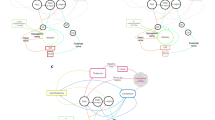Abstract
A sucrose-gap technique was used to study the development of neuromuscular transmission in the taenia coli of fetal, 1- to 2-day-old, 3- to 4-week-old and 3-month-old guinea-pigs. In addition, the effects of exogenous, α,β-methylene adenosine 5′-triphosphate (ATP), noradrenaline, vasoactive intestinal polypeptide (VIP) and carbachol were examined. Taking the response to a single pulse of electrical field stimulation as the index of a developed neuromuscular junction, it was apparent that the non-adrenergic inhibitory system arose before, and matured more quickly than, the cholinergic system. The inhibitory system was present by 8 weeks of gestation in some fetuses, but, in contrast, excitatory cholinergic transmission was not seen until birth. As evidenced by responses to carbachol, α,β-methylene ATP and VIP, cholinergic, purinergic and VIP receptors were present on the smooth muscle at the earliest ages studied. No changes in sensitivity to these agents were noted throughout development, although in adults the level of the maximum responses increased.
Similar content being viewed by others
References
Artemenko DP, Bury VA, Vladimirova IA, Shuba MF (1982) Modification of the single sucrose-gap method. Fiziol Zh 28:374–380
Bauer V, Kuriyama H (1982) The nature of non-cholinergic, non-adrenergic transmission in the guinea-pig ileum. J Physiol (Lond) 332:375–391
Boeckxstaens GE, Pelckmans PA, Bult H, De Man JG, Herman AG, Van Maercke YM (1990) Non-adrenergic relaxation mediated by nitric oxide in the canine ileocolonic junction. Eur J Pharmacol 190:239–246
Boreus LO, McMurphy DM (1971) Ontogenetic development of cholinergic receptor function in guinea-pig ileum. Acta Physiol Scand 81:143–144
Bult H, Boeckxstaens GE, Pelckmans PA, Jordaens FH, Van Maercke YM, Herman AG (1990) Nitric oxide as an inhibitory non-adrenergic non-cholinergic neurotransmitter. Nature 345:346–347
Burn JH (1968) The development of adrenergic fibres. Br J Pharmacol 32:575–582
Burnstock G (1981) Neurotransmitter and trophic factors in the autonomic nervous system. J Physiol (Lond) 313:1–35
Bywater RAR, Taylor GS (1983) Non-cholinergic fast and slow depolarisation in the guinea-pig ileum. J Physiol (Lond) 340:47–56
Epstein ML, Sherman D, Gershon MD (1980) Development of serotonergic neurons in the chick duodenum. Dev Biol 77:22–40
Furness JB, McLean JR, Burnstock G (1970) Distribution of adrenergic nerves and changes in neuromuscular transmission in the mouse vas deferens during postnatal development. Dev Biol 21:491–505
Ganitkevich VYA, Baidan LV, Tishkin SM, Shuba MF (1982) A study of synaptic currents in smooth muscles. Dokl Adad Nauk SSSR 263:1022–1024
Gershon MD, Thompson EB (1973) The maturation of neuromuscular function in a multiply innervated structure: development of the longitudinal smooth muscle of the foetal mammalian gut and its cholinergic excitatory, adrenergic inhibitory, and non-adrenergic inhibitory innervation. J Physiol (Lond) 234:257–277
Gintzler AR, Rothman TP, Gershon MD (1980) Ontogeny of opiate mechanisms in relation to the sequential development of neurons known to be components of the guinea-pig enteric nervous system. Brain Res 189:31–48
Grider JR, Rivier JR (1990) Vasoactive intestinal peptide (VIP) as transmitter of inhibitory motor neurons of the gut: evidence from use of selective VIP antagonists and VIP antiserum. J Pharmacol Exp Ther 253:738–742
Gulati OD, Panchal DI (1978) Some observations on the development of adrenergic innervation in rabbit intestine. Br J Pharmacol 64:247–251
Hills JM, Collis CS, Burnstock G (1983) The effects of VIP on the electrical activity of guinea-pig intestinal smooth muscle. Eur J Pharmacol 88:371–376
Hoyle CHV (1987) A modified single sucrose-gap: junction potentials and electrotonic potentials in gastrointestinal smooth muscle. J Pharmacol Methods 18:219–226
Hoyle CHV, Burnstock G (1989) Neuromuscular transmission in the gastrointestinal tract. In: Wood JD (ed) Handbook of physiology, section 6. The gastrointestinal system, vol 1. Motility and circulation, American Physiological Society, Bethesda, pp 435–464
Hoyle CHV, Kamm MA, Burnstock G, Lennard-Jones JE (1990) Enkephalins inhibit non-adrenergic, non-cholinergic inhibitory neuromuscular transmission in the circular muscle of the human colon via prejunctional δ-opioid receptors. J Physiol (Lond) 431:465–478
Ito S, Kimura A, Ohga A (1988) Development of non-cholinergic, non-adrenergic excitatory and inhibitory responses to intramural nerve stimulation in rat stomach. Br J Pharmacol 93:684–692
MacKenzie I, Burnstock G (1980) Evidence against vasoactive intestinal polypeptide being the non-adrenergic, non-cholinergic inhibitory transmitter in the pig taenia coli. Eur J Pharmacol 67:255–264
Miyazaka H, Ohga A, Saito K (1982) Development of motor response to intramural nerve stimulation and to drugs in rat small intestine. Br J Pharmacol 76:531–540
Niel JP, Bywater RAR, Taylor GS (1983) Effect of substance P on non-cholinergic fast and slow post-stimulus depolarisation in the guinea-pig ileum. J Auton Nerv Syst 9:573–584
Rand MJ, Li CG (1990) Nitric oxide mediates non-adrenergic non-cholinergic relaxation in some neuroeffector systems: examples of nitrergic transmission. Eur J Pharmacol 183:1144
Read JB, Burnstock G (1970) Development of the adrenergic innervation and chromaffin cells in the human fetal gut. Dev Biol 22:513–534
Saffrey JM, Burnstock G (1988) Distribution of peptide-immunoreactive nerves in the foetal and newborn guinea-pig caecum. Cell Tissue Res 253:105–114
Shuttleworth CWR, Murphy R, Furness JB (1991) Evidence that nitric oxide participates in non-adrenergic inhibitory transmission to intestinal muscle in the guinea-pig. Br J Pharmacol 130:77–80
Sikora LKJ, Buchan AMJ, Leva JG, McIntosh CHS, Brown JC (1984) VIP-innervation of rat intestine: a development study with monoclonal antibodies. Peptides 5:231–237
Vladimirova IA, Shuba MF (1984) Synaptic processes in smooth muscle. Neurophysiology 16:307–319
Author information
Authors and Affiliations
Rights and permissions
About this article
Cite this article
Zagorodnyuk, V.P., Hoyle, C.H.V. & Burnstock, G. An electrophysiological study of developmental changes in the innervation of the guinea-pig taenia coli. Pflügers Arch. 423, 427–433 (1993). https://doi.org/10.1007/BF00374937
Received:
Revised:
Accepted:
Issue Date:
DOI: https://doi.org/10.1007/BF00374937




